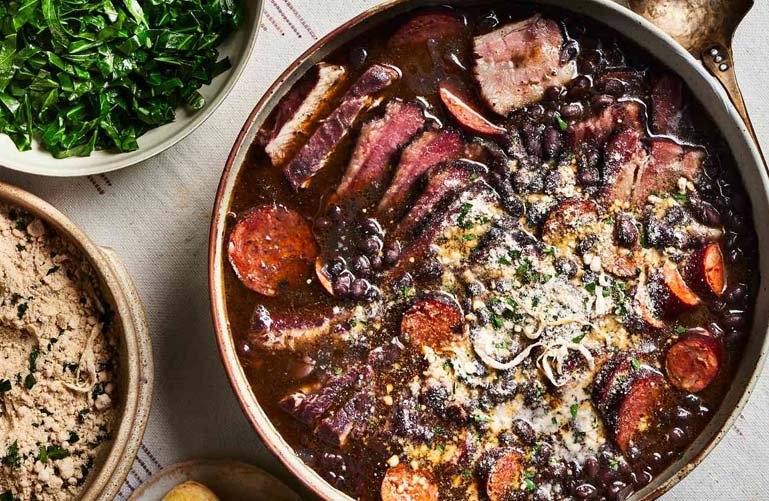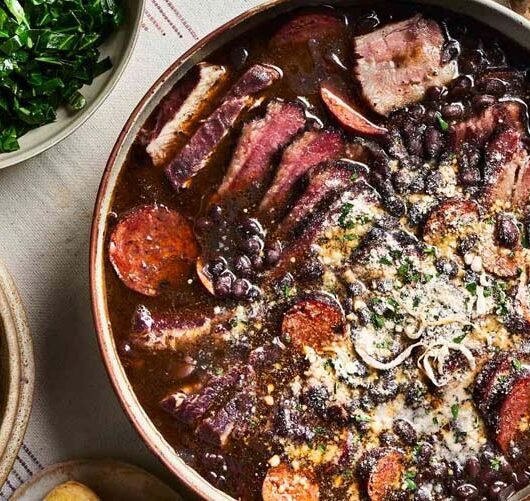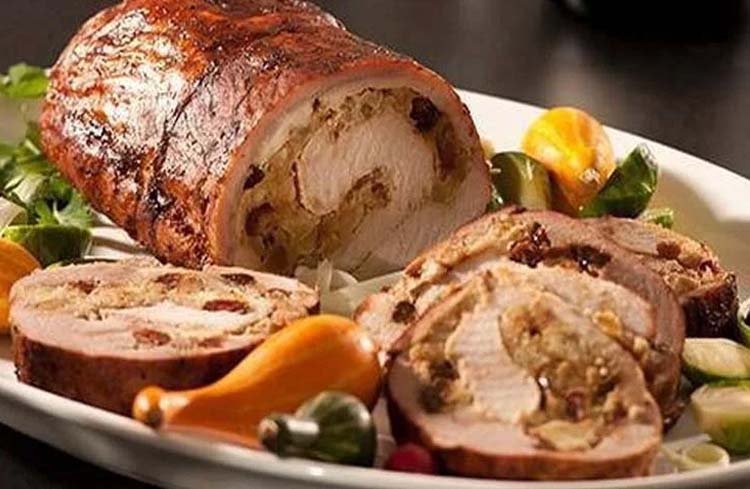Feijoada is a hearty, flavorful stew that combines soft black beans with a variety of juicy meats. The aroma and flavor of the ingredients merge over low heat, creating a comforting dish served with white rice, crispy farofa, and refreshing orange slices. Get ready to enjoy a unique Brazilian culinary experience in your own kitchen.

Feijoada and health benefits
Feijoada, considered the emblematic dish of Brazil, is much more than a simple combination of black beans and various meats. With its rich history and deep flavors, feijoada has captured the hearts and palates of Brazilian cuisine lovers around the world. But beyond its delicious flavor, feijoada also offers a series of health benefits. In this essay, we will explore the nutritional components and benefits that this traditional stew can bring to our well-being.
Nutritional wealth:
Feijoada is an abundant source of essential nutrients. Black beans, the base of this dish, are an excellent source of dietary fiber, which contributes to digestive health and helps keep blood sugar levels stable. In addition, they are rich in vegetable proteins, ideal for vegetarians and vegans looking for an alternative to proteins of animal origin.
The meats used in feijoada, such as pork and beef, provide high-quality proteins, as well as B vitamins and minerals such as iron and zinc. These nutrients are essential for the formation of red blood cells, maintaining the immune system, and proper brain function.
Health benefits:
- Cardiovascular health: Feijoada contains healthy fats from pork and the olive oil used in its preparation. Additionally, black beans are associated with reducing LDL cholesterol (“bad cholesterol”) in the body, which helps maintain a healthy cardiovascular system.
- Weight control: The combination of protein and fiber in feijoada can help promote satiety and control appetite. This can help maintain a healthy weight and avoid overeating.
- Energy and vitality: The nutrients present in feijoada provide a long-lasting source of energy. The proteins and carbohydrates present in this dish offer an ideal combination to maintain high energy levels during the day.
- Gut health: The black beans used in feijoada are rich in fiber, which favors intestinal transit and promotes a healthy intestinal microbiota. Additionally, dietary fiber helps prevent constipation and other digestive conditions.
History of Feijoada
Feijoada is an emblematic dish of Brazilian cuisine with a fascinating history that reflects the country's cultural diversity and its colonial past. Its origin dates back to the times of slavery in Brazil, during the 17th and 18th centuries.
During colonial times, Brazil was a Portuguese colony that relied heavily on African slave labor on plantations. The African slaves brought to Brazil by the Portuguese had a diet based primarily on locally available foods, such as beans, rice, pork, and other inexpensive and abundant ingredients.
Feijoada was born in this context as a dish created by African slaves using simple and affordable ingredients that they could easily find. It consisted of a large pot where various cuts of pork (such as ears, tail, feet, ribs, etc.) were cooked along with black beans and other available vegetables, seasonings and spices. Slaves cooked feijoada in large quantities and shared it among themselves as a way to eat together and keep their cultural traditions alive in a hostile environment.
Over time, feijoada became a popular dish throughout Brazilian society, not only among slaves, but also among Portuguese settlers and the general population. It was adapted and refined over the years, and today it is considered one of the most representative dishes of Brazilian cuisine.
Feijoada is usually served with white rice, sliced oranges, farofa (cassava flour toasted with butter and other seasonings), and fermented cabbage. It is a dish that is traditionally eaten on Saturdays, being a popular option for family meals and social gatherings.
Although its origin is linked to the history of slavery in Brazil, feijoada has transcended its past and has become a symbol of Brazilian culinary identity, representing the cultural diversity and gastronomic richness of the country.
Maybe you might like: Cornstarch alfajores
Image credit: freepik



